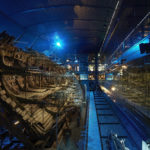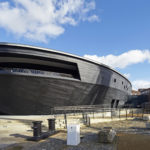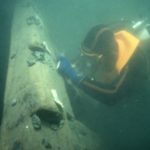The Mary Rose was Henry VIII's flagship, one of the first projects he commissioned with his own money when he became king in 1509. The ship sank on July 19, 1545, during the Battle of the Solent, after serving 34 years as a warship. Scholars still disagree about why it sank. Different theories posit that it was overloaded with new guns, a strong gust of wind capsized the vessel, or that the French sank it.
Although its reasons for going down remain a mystery, October 11, 2017, marked the 35th anniversary of the raising of the Mary Rose from the Solent seabed off the coast of Portsmouth. It is the only 16th-century warship on display anywhere in the world.
Raising the Mary Rose
The ship spent 437 years underwater, until 1982 when it was raised from the seabed and housed at Portsmouth Historic dockyard. The raising was the culmination of years of underwater archaeological work. In 1965, a military historian named Alexander McKee (1918-1992), set out to locate the Mary Rose. What began as a passion project and a fairly amateur operation became something of global phenomenon when an estimated 60 million people watched the raising in 1982. A team of amateur divers worked on the Mary Rose, many of them learning basic archaeological skills in order to support its excavation. Similarly, some of the archaeologists involved learned to scuba dive just to work on the project.
Dr. Alex Hildred, now now head of research and curator of ordnance and human remains at the Mary Rose Trust, was one of the divers who worked on the project. She described the diving conditions in the Solent, the stretch of water off the South coast of the U.K., as challenging. Low visibility was often an issue and, at the beginning of the project, the team only uncovered parts of the ship, with most buried in the mud. The divers worked in trenches and soon discovered thousands of objects preserved there before gradually uncovering the whole ship.






Britain's Pompeii
Historian David Starkey described the Mary Rose as "Britain's Pompeii" after divers recovered some 19,000 artifacts along with the shipwreck. Together, they provide fascinating insight into life onboard a 16th-century warship, and into Tudor life more broadly. Along with guns, ropes, swords and armor, divers recovered personal items such as a backgammon set, musical instruments, nit combs and rosary beads. The ship had a crew of 500 men but tragically only a handful survived, many trapped beneath the anti-boarding netting as the ship went down. Divers found the remains of 179 crew members, although archaeologists were only able to reconstruct 92 of them. Most of the skeletons were found in areas that suggested who they were, such as the cook in the galley. The team found also found a skeleton of a small dog, now housed in the museum and known affectionately as 'Hatch.'
Conserving the Mary Rose
Conserving the Mary Rose is an ongoing project. In 1982, when it was first raised, the wreck was sprayed with fresh water to remove any remaining sediment and salts, as well as to prevent the wood from drying out. During the 437 years the Mary Rose spent underwater, the cell structure of the timbers weakened. Drying the ship out without treatment would have caused it to shrink and collapse. So, in 1994, the conservation team began to spray the wreckage with polyethylene glycol, a wax that penetrated the wood and replaced the water. Once the levels of penetration were high enough, they could turn off the spray, as they did on April 29, 2013, after 19 years, and allow the ship to dry.
A specially dedicated museum now stands around the ship. Here, visitors can enjoy spectacular views of the ship on three sides via nine galleries through floor-to-ceiling glazing on the lower and main decks. Video projections onto the ship show simulations of the crew at work, a gun crew in action, someone at the mercy of the barber-surgeon, and the cook preparing food in the galley.
Anniversary celebration
To celebrate the 35th anniversary of the ship's raising in 2017, divers who originally worked on the wreck site in the 1970s and 1980s — and now based around the world on a range of diving projects — returned to the Mary Rose Museum for a reunion. Stay tuned for our next story covering the event.
By guest author Jessica Niñerola
The post Raising the Shipwreck of the Mary Rose appeared first on Scuba Diver Life.
from Scuba Diver Life http://ift.tt/2tWoK4j
No comments:
Post a Comment